Items
Tag
impressionism
-
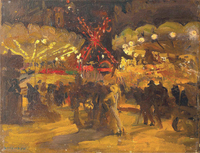 The Moulin Rouge (nighttime) "The Moulin Rouge, much represented at the time by the artists as a symbol of a Parisian bohemia, emerges from the city landscape. In a nocturnal atmosphere, which the colorist skillfully works, sensations of that zone of the city are represented through the planning of its structure and by marking, here and there, the human movement. Painted in Paris in the early nineties where Sousa Lopes was living as a pensioner, the painting reveals a clear influence of Claude Monet. The blurring of the outlines or the media screen between the viewer and the subject reflect a treatment with Impressionist references. In a dominant tone of dark browns appear small red balls that adorn the mill, manifestation of a proper taste by the chromatic valorization of elements of the composition." -Google Arts and Culture
The Moulin Rouge (nighttime) "The Moulin Rouge, much represented at the time by the artists as a symbol of a Parisian bohemia, emerges from the city landscape. In a nocturnal atmosphere, which the colorist skillfully works, sensations of that zone of the city are represented through the planning of its structure and by marking, here and there, the human movement. Painted in Paris in the early nineties where Sousa Lopes was living as a pensioner, the painting reveals a clear influence of Claude Monet. The blurring of the outlines or the media screen between the viewer and the subject reflect a treatment with Impressionist references. In a dominant tone of dark browns appear small red balls that adorn the mill, manifestation of a proper taste by the chromatic valorization of elements of the composition." -Google Arts and Culture -
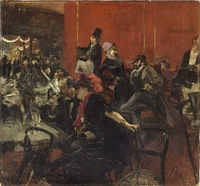 Feast Scene "Born in 1842 in Ferrara, a town in northern Italy, Boldini became firmly established in Paris from 1871 onwards, where he very quickly became a fashionable portraitist and an important witness to the frenetic life of this rapidly expanding, modern city, with its streets, cafés and dances. Here, Boldini is certainly depicting the Moulin-Rouge just after it opened in 1889. The establishment quickly became one of the hot spots of Parisian nightlife. The vigorous and dynamic brushstrokes and the liveliness of the red recreate the feeling of fun and freedom, sweeping along diners and dancers alike in a brilliantly rendered composition. Before the Musée d'Orsay acquired it in 2010, this painting, certain parts of which remain as in sketch form, had only ever been exhibited once, in 1933 in New York." -Google Arts and Culture
Feast Scene "Born in 1842 in Ferrara, a town in northern Italy, Boldini became firmly established in Paris from 1871 onwards, where he very quickly became a fashionable portraitist and an important witness to the frenetic life of this rapidly expanding, modern city, with its streets, cafés and dances. Here, Boldini is certainly depicting the Moulin-Rouge just after it opened in 1889. The establishment quickly became one of the hot spots of Parisian nightlife. The vigorous and dynamic brushstrokes and the liveliness of the red recreate the feeling of fun and freedom, sweeping along diners and dancers alike in a brilliantly rendered composition. Before the Musée d'Orsay acquired it in 2010, this painting, certain parts of which remain as in sketch form, had only ever been exhibited once, in 1933 in New York." -Google Arts and Culture -
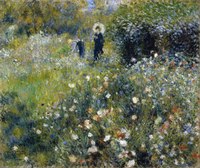 Woman with a Parasol in a Garden "In Woman with a Parasol in a Garden, Renoir's language is wholly impressionistic: in a setting lacking a visible horizon, the flowers and shrubs are created with tiny dabs of colour, providing a constant interweaving of textures around the two small figures. The woman, whose parasol shades her from the sun, stands close to the man as he leans down, perhaps to pick a flower, hinting at an intimate relationship. Contrary to what one may think, this canvas was not painted in the countryside but in the garden of Renoir's new studio in Montmartre. His friend George Rivière recalled: 'As soon as Renoir entered the house, he was charmed by the view of this garden, which looked like a beautiful abandoned park." -Google Arts and Culture
Woman with a Parasol in a Garden "In Woman with a Parasol in a Garden, Renoir's language is wholly impressionistic: in a setting lacking a visible horizon, the flowers and shrubs are created with tiny dabs of colour, providing a constant interweaving of textures around the two small figures. The woman, whose parasol shades her from the sun, stands close to the man as he leans down, perhaps to pick a flower, hinting at an intimate relationship. Contrary to what one may think, this canvas was not painted in the countryside but in the garden of Renoir's new studio in Montmartre. His friend George Rivière recalled: 'As soon as Renoir entered the house, he was charmed by the view of this garden, which looked like a beautiful abandoned park." -Google Arts and Culture -
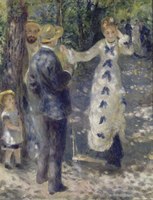 The Swing "A young man seen from the back is talking to a young woman standing on a swing, watched by a little girl and another man, leaning against the trunk of a tree. Renoir gives us the impression of surprising a conversation – as if in a snapshot, he catches the glances turned towards the man seen from the back. The young woman is looking away as if she were embarrassed. The foursome in the foreground is balanced by the group of five figures sketchily brushed in the background. The Swing has many points in common with The Ball at the Moulin de la Galette. The two pictures were painted in parallel in the summer of 1876. The models in The Swing, Edmond, Auguste Renoir's brother, the painter Robert Goeneutte and Jeanne, a young woman from Montmartre, figure among the dancers in The Ball. The same carefree atmosphere infuses both pictures. As in The Ball, Renoir is particularly trying to catch the effects of sunlight dappled by the foliage. The quivering light is rendered by the patches of pale colour, particularly on the clothing and the ground. This particularly annoyed the critics when the painting was shown at the Impressionist exhibition of 1877. The Swing nonetheless found a buyer – Gustave Caillebotte, who also bought The Ball at the Moulin de la Galette." -Google Arts and Culture
The Swing "A young man seen from the back is talking to a young woman standing on a swing, watched by a little girl and another man, leaning against the trunk of a tree. Renoir gives us the impression of surprising a conversation – as if in a snapshot, he catches the glances turned towards the man seen from the back. The young woman is looking away as if she were embarrassed. The foursome in the foreground is balanced by the group of five figures sketchily brushed in the background. The Swing has many points in common with The Ball at the Moulin de la Galette. The two pictures were painted in parallel in the summer of 1876. The models in The Swing, Edmond, Auguste Renoir's brother, the painter Robert Goeneutte and Jeanne, a young woman from Montmartre, figure among the dancers in The Ball. The same carefree atmosphere infuses both pictures. As in The Ball, Renoir is particularly trying to catch the effects of sunlight dappled by the foliage. The quivering light is rendered by the patches of pale colour, particularly on the clothing and the ground. This particularly annoyed the critics when the painting was shown at the Impressionist exhibition of 1877. The Swing nonetheless found a buyer – Gustave Caillebotte, who also bought The Ball at the Moulin de la Galette." -Google Arts and Culture -
 Montmartre: behind the Moulin de la Galette "Van Gogh painted this large landscape near his home on the hill of Montmartre. The north side of the hill was dotted with vegetable gardens. Van Gogh painted with quick, loose brushstrokes, revealing the influence of (Neo)-Impressionism. The painting was shown in 1888, alongside the work of other cutting-edge artists at the Salon des Indépendants exhibition. Van Gogh was highly satisfied with this landscape. He had considered donating it to the Museum of Modern Art in The Hague, which had opened in 1884, in order to show his new work to his fellow countrymen. (See letter to Theo van Gogh, 3 April 1888). It was a plan he would never actually carry out." -Google Arts and Culture
Montmartre: behind the Moulin de la Galette "Van Gogh painted this large landscape near his home on the hill of Montmartre. The north side of the hill was dotted with vegetable gardens. Van Gogh painted with quick, loose brushstrokes, revealing the influence of (Neo)-Impressionism. The painting was shown in 1888, alongside the work of other cutting-edge artists at the Salon des Indépendants exhibition. Van Gogh was highly satisfied with this landscape. He had considered donating it to the Museum of Modern Art in The Hague, which had opened in 1884, in order to show his new work to his fellow countrymen. (See letter to Theo van Gogh, 3 April 1888). It was a plan he would never actually carry out." -Google Arts and Culture -
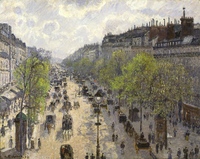 Boulevard Montmartre, Spring "One of a series of fourteen works painted between February and April, Boulevard Montmartre: Spring epitomizes Pissarro’s ability to seize unique moments, such as a specific hour or season. From his hotel room overlooking the boulevard, he captured the life and movement of the street in small, rapid brushstrokes. Pissarro considered his work very modern in conception: “I am delighted to be able to paint these Paris streets that people have come to call ugly, but which are so silvery, so luminous and vital.” Until 1935, Boulevard Montmartre: Spring was in the collection of Max Silberberg, a Jewish industrialist and art collector from Breslau, Germany. It was then sold in a forced sale by Paul Graupe’s auction house in Berlin. Max Silberberg and most of his family perished in the Holocaust. In 1999, representatives of the Silberberg Estate asked the Museum and its American Friends to make restitution of the painting. Ownership was restored to Max Silberberg’s daughter-in-law and heir. Boulevard Montmartre: Spring remains in Jerusalem on extended loan through her generosity. Formerly a bequest of John and Frances L. Loeb, New York, to American Friends of the Israel Museum, Now extended loan from the daughter-in-law of Max Silberberg, Breslau." -Google Arts and Culture
Boulevard Montmartre, Spring "One of a series of fourteen works painted between February and April, Boulevard Montmartre: Spring epitomizes Pissarro’s ability to seize unique moments, such as a specific hour or season. From his hotel room overlooking the boulevard, he captured the life and movement of the street in small, rapid brushstrokes. Pissarro considered his work very modern in conception: “I am delighted to be able to paint these Paris streets that people have come to call ugly, but which are so silvery, so luminous and vital.” Until 1935, Boulevard Montmartre: Spring was in the collection of Max Silberberg, a Jewish industrialist and art collector from Breslau, Germany. It was then sold in a forced sale by Paul Graupe’s auction house in Berlin. Max Silberberg and most of his family perished in the Holocaust. In 1999, representatives of the Silberberg Estate asked the Museum and its American Friends to make restitution of the painting. Ownership was restored to Max Silberberg’s daughter-in-law and heir. Boulevard Montmartre: Spring remains in Jerusalem on extended loan through her generosity. Formerly a bequest of John and Frances L. Loeb, New York, to American Friends of the Israel Museum, Now extended loan from the daughter-in-law of Max Silberberg, Breslau." -Google Arts and Culture -
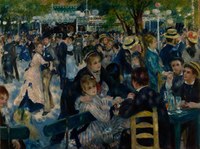 Dance at Le Moulin de la Galette "This painting is doubtless Renoir's most important work of the mid 1870's and was shown at the Impressionist exhibition in 1877. Though some of his friends appear in the picture, Renoir's main aim was to convey the vivacious and joyful atmosphere of this popular dance garden on the Butte Montmartre. The study of the moving crowd, bathed in natural and artificial light, is handled using vibrant, brightly coloured brushstrokes. The somewhat blurred impression of the scene prompted negative reactions from contemporary critics. This portrayal of popular Parisian life, with its innovative style and imposing format, a sign of Renoir's artistic ambition, is one of the masterpieces of early Impressionism." -Google Arts and Culture
Dance at Le Moulin de la Galette "This painting is doubtless Renoir's most important work of the mid 1870's and was shown at the Impressionist exhibition in 1877. Though some of his friends appear in the picture, Renoir's main aim was to convey the vivacious and joyful atmosphere of this popular dance garden on the Butte Montmartre. The study of the moving crowd, bathed in natural and artificial light, is handled using vibrant, brightly coloured brushstrokes. The somewhat blurred impression of the scene prompted negative reactions from contemporary critics. This portrayal of popular Parisian life, with its innovative style and imposing format, a sign of Renoir's artistic ambition, is one of the masterpieces of early Impressionism." -Google Arts and Culture